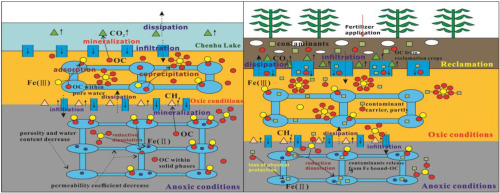当前位置:
X-MOL 学术
›
Environ. Pollut.
›
论文详情
Our official English website, www.x-mol.net, welcomes your
feedback! (Note: you will need to create a separate account there.)
Transfer and transformation mechanisms of Fe bound-organic carbon in the aquitard of a lake-wetland system during reclamation.
Environmental Pollution ( IF 7.6 ) Pub Date : 2020-04-02 , DOI: 10.1016/j.envpol.2020.114441 Rui Liu 1 , Teng Ma 1 , Chaohong Lin 1 , Juan Chen 1 , Kun Lei 1 , Xin Liu 1 , Wenkai Qiu 1
Environmental Pollution ( IF 7.6 ) Pub Date : 2020-04-02 , DOI: 10.1016/j.envpol.2020.114441 Rui Liu 1 , Teng Ma 1 , Chaohong Lin 1 , Juan Chen 1 , Kun Lei 1 , Xin Liu 1 , Wenkai Qiu 1
Affiliation

|
Organic carbon (OC) can help control greenhouse gas emissions by participating in biogeochemical reactions and preventing the migration of contaminants in groundwater systems. The association of OC with Fe (Iron) oxide minerals plays a significant role in stabilizing OC and regulating the biogeochemical cycles of OC on the earth's surface. Reclaiming farmland from lakes changes an original lake into a wetland, but the destiny of Fe bound-OC in the underlying aquitard during this process has been poorly understood. The mechanisms of migration and transformation of Fe bound-OC were investigated in subsurface aquitard sediments of three typical boreholes in the Chen Lake wetland, central China. The Fe bound-OC content in the natural sedimentary conditions (borehole A), transition area (borehole B), and intensive reclamation area (borehole C) were 0.17-3.87, 0.28-3.98 and 0.13-7.08 mg g-1, respectively. The reclamation changed the redox, water, and infiltration conditions of the surface environment, resulting in a transformation of Fe oxides phases, and then cause the change of content and structure of Fe bound-OC. The fresh organic matter provided by undecomposed crops causes oxygen- and nitrogen-rich compounds to combine with Fe oxides extensively through adsorption, resulting in higher δ13C values of Fe bound-OC than non-Fe bound-OC. Fe bound-OC has strong resistance to biodegradation. The Fe bound-OC: total OC ratios generated by adsorption and coprecipitation on the surface layer (0 to -3.5 m) of borehole C was 10.37% and 18.86%, 6.92% and 12.46% higher than those of boreholes A and B, respectively. Coprecipitation has a stronger OC-binding ability and enriches more carboxylates and aromatics, while adsorption gradually assumed a dominant position in OC-Fe interaction in deep aquitard. The reduction dissolution of Fe oxide causes Fe bound-OC to transfer into pore water, leading to an increase of Fe ion and dissolved OC in deep strata.
更新日期:2020-04-03


















































 京公网安备 11010802027423号
京公网安备 11010802027423号